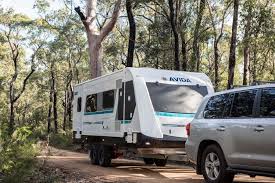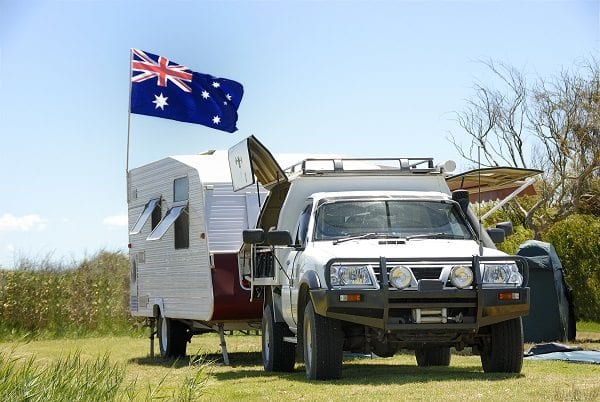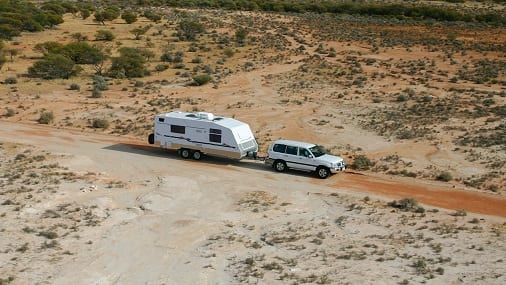Whether you are new to towing a caravan, or if you are just looking for ways to make the experience easier, there are plenty of things you can do to take some of the stress out of towing a caravan. We’ve put together some of our best advice that will hopefully help you to enjoy your next caravan adventure just that little bit more.
Pre-Travel Checklist
Regardless of your experience towing, make sure you always run through the same pre-towing checks. The day you get complacent is the day something will most likely go wrong. These checks won’t take long, but it is good practice to do them each time you hook up the van.
- Ensure your coupling is properly connected. Make sure the safety chains, break-away wire and trailer plugs are all secure
- Check the handbrake is released
- Make sure gas cylinders are turned off
- If you have a weight distribution hitch, ensure it is secure, tensioned and safety pins are in place
- Check all windows are closed, wheel chocks are removed and stabiliser legs are raised
- Make sure all roof hatches are closed and antennas etc. are secure
- Check everything inside the van is properly secured
- Get someone to check the van’s tail lights are working


Weight
All vehicles have a maximum load that can safely be towed, it is important that this limit is not exceeded. There are a lot of factors to consider when it comes to weight including the size of the vehicle, the weight of the caravan, whether or not you have electric brakes fitted and the load you plan to carry. There are some legal restrictions when it comes to towing weight limits, so it is vital to know the limits of your rig before hitting the road. Weight distribution is also important when it comes to towing. A caravan that is unbalanced can be at higher risk of sway. So be sure to plan out how to pack your van to ensure everything is balanced how it should be for a safe trip.
Driving
If you have never towed before, jumping in the car with a caravan hitched on the back can be a daunting task on its own. But there are a few unique challenges that come with towing a caravan that it is important to be prepared for. For general driving, always remember to leave a larger distance between you and the vehicle in front of you. With the extra weight on the back, your stopping distance is much greater, so factor that in when you’re on the road.
Narrow Roads
It is important to always pay attention to any surrounding obstacles such as awnings, posts, large vehicles and guard rails. If you encounter any of these try to give them as wide a berth as safely possible. Try to avoid getting between two wide vehicles if it is avoidable and stay in the left lane wherever it is practical to do so.
Corners
When taking a corner, your caravan will always take a shorter path than your vehicle. For this reason, you should always try to take the widest path possible around corners. The general rule of thumb for corners is to turn a bit later than you usually would and as wide as the road allows. You can also apply this technique when going around roundabouts. This may seem daunting at first, but with time and practice, you will soon get a feel for how to handle your vehicle and caravan around corners.
Handling Sway
Towing a caravan at speed on a highway can be one of the biggest challenges for anyone new to the experience. Avoiding caravan sway is one of the most important things to keep in mind when towing. To start with, your van should be loaded so that it is correctly balanced. A weight distribution hitch can be extremely helpful too. It is also important to make sure your tyre pressures are correct before hitting the road.
When driving on the highway, keep as wide a berth as possible from large vehicles as you pass (or they pass you). This will help to prevent the air they disturb from affecting your caravan. If you don’t have room to move over, slow down as the vehicle passes. If you see any warning signs for a high wind area, make sure you slow down in preparation.
If you do notice your van starting to sway, gently ease off the accelerator. Once your speed has been reduced by 10-15km, apply your electric brake override and slowly speed back up. This should straighten up your rig and stop the sway. If you have an electric stability control system or sway control system installed on your caravan, the unit will take care of this process for you.
For the most part, the basic principal of towing a caravan comes down to extra diligence. You need to pay more attention to what you are doing, the area around you and what others are doing on the road.
Reversing
The trick to mastering reversing is practice. If you get the chance try to find a place to practice reversing before you head off on your first trip. An empty car park is a great option.
Take it Slow
If you are moving at a slower pace, you will have more time to make minor steering adjustments before you get yourself in an undesirable situation. Patience is critical, especially if you are new to the whole experience.
Use Your Mirrors
Use your left and right mirrors to monitor the rear corners of the trailer, this will give you an indication of any trailer change in direction. If you see too much of the trailer on one side, turn the wheel towards that mirror to straighten up.
Shift Your Hands to Turn
Move your hands from the top of the steering wheel to the bottom. Moving your hands to the left will now move the caravan to the left and vice versa. Once you have established the right amount of turn, straighten up to the point where the vehicle follows the caravan on the same arc.
Getting out of a jackknife
If you end up in a jackknife position, there are a few things to do to get out of it.
- Stop immediately before you cause any damage.
- Turn the steering full lock away from the angle of the jackknife.
- Move forward slowly and this will straight the combination very quickly.
Reversing into a Caravan Site
When reverse parking, take it slow and if you can, set up markers to simplify your parking.
- Remove your Weight Distribution Bars prior to reversing into the parking bay.
- Identify any hazards in or around your site.
- Take it slowly and use a spotter (or rear vision camera) to stop you from hitting anything or cause damage.


